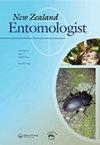当mānuka棒虫的不同性别种群交叉时,受精没有障碍
IF 0.4
4区 农林科学
Q4 ENTOMOLOGY
引用次数: 0
摘要
本文章由计算机程序翻译,如有差异,请以英文原文为准。
No barrier to fertilisation when different sexual populations of the mānuka stick insect are crossed
ABSTRACT The mānuka stick insect Clitarchus hookeri (White) is facultatively parthenogenetic, but females from sexual populations that have mated with males from their own population do not produce any offspring via asexual reproduction. In contrast, females from parthenogenetic populations of C. hookeri mate with males (in captivity) but show a partial barrier to fertilisation with more than 90% of their offspring resulting from asexual reproduction post mating. Captive crossing experiments with parthenogenetic females require the mating of individuals from different populations (sexual and parthenogenetic), thus potential intraspecific differences bring a confounding element to these experiments. Experiments mating sexual females with males from different sexual populations were undertaken to determine whether offspring resulting from such a cross would be the result of sexual or parthenogenetic reproduction. Virgin females and males were collected from two sexual populations known to represent distinct genetic lineages (Waikato and Whanganui). Eleven adult females were caged with non-local males and eggs collected post-mating. Approximately equal numbers of sons and daughters hatched (168 female; 210 male) suggesting all offspring were the result of sexual reproduction. In these intraspecific crosses no barriers to fertilisation were detected, suggesting that in the absence of males the decay of some sexual trait in Phasmids can occur in fewer than 100 generations.
求助全文
通过发布文献求助,成功后即可免费获取论文全文。
去求助
来源期刊

New Zealand Entomologist
ENTOMOLOGY-
CiteScore
0.70
自引率
33.30%
发文量
3
审稿时长
>12 weeks
期刊介绍:
The invertebrate diversity of New Zealand is of great interest worldwide because of its geographic isolation and geological history. The New Zealand Entomologist plays an important role in disseminating information on field-based, experimental, and theoretical research.
The New Zealand Entomologist publishes original research papers, review papers and short communications. We welcome submissions in all aspects of science regarding insects and arthropods in a New Zealand or Australasian setting. The journal’s subject matter encompasses taxonomy, phylogenetics, biogeography, biological control and pest management, conservation, ecology and natural history.
The journal is the official publication of the Entomological Society of New Zealand. Papers published or submitted elsewhere for publication will not be considered, but publication of an abstract or summary elsewhere (e.g. conference proceedings) does not preclude full publication in the New Zealand Entomologist. Accepted papers become copyright of the Entomological Society of New Zealand. The journal is published in English, but we also welcome publication of abstracts in Maori.
 求助内容:
求助内容: 应助结果提醒方式:
应助结果提醒方式:


